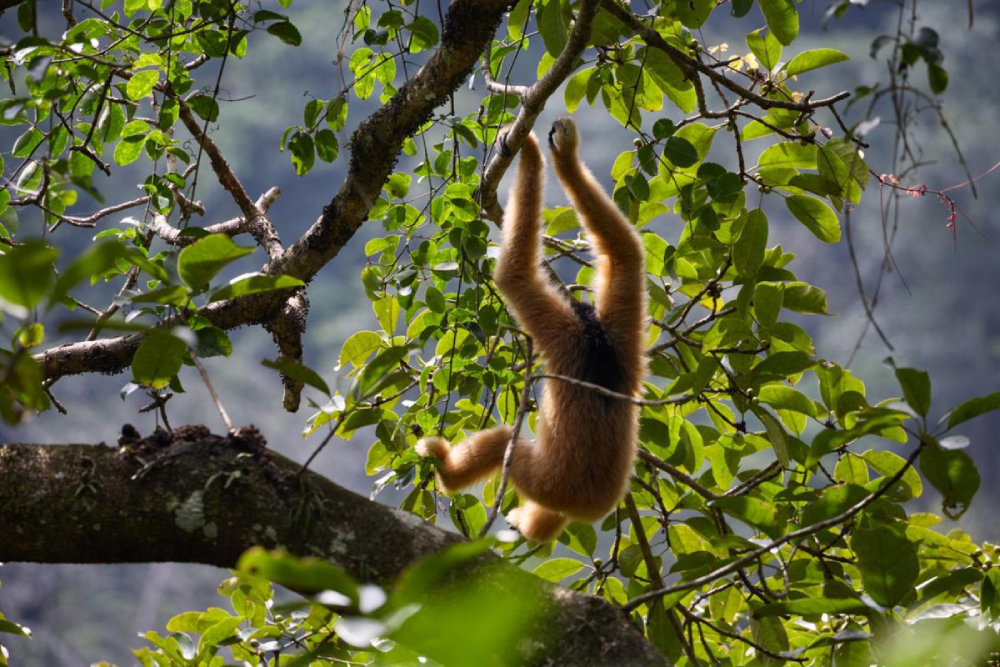In the dense forests straddling the border between Vietnam and China, a small, elusive creature swings through the canopy with acrobatic grace. This is the Cao Vit gibbon (Nomascus nasutus), an iconic and critically endangered species known for its distinctive call echoing through the misty forests. As one of the rarest primate species on the planet, the Cao Vit gibbon holds immense ecological and cultural significance. However, they face habitat loss, hunting, and the encroachment of human activities. In this article, we delve into the fascinating world of the Cao Vit gibbon, exploring its biology, conservation status, and the efforts underway to ensure its survival.
Biology and Habitat of Cao Vit Gibbon
This breed, also known as the Eastern black crested gibbon, is a species of small ape belonging to the family Hylobatidae. Characterized by its glossy black fur and distinctive tuft of hair on its head, this arboreal primate is perfectly adapted to life in the dense subtropical and tropical forests of northeastern Vietnam and southern China. With long arms, specialized hand anatomy for brachiation (swinging from branch to branch), and a specialized mode of locomotion known as arm swinging, the Cao Vit gibbon navigates the forest canopy with agility and speed.
These gibbons are primarily frugivorous, feeding on a variety of fruits, leaves, flowers, and occasionally insects. Their diet plays a crucial role in seed dispersal and forest regeneration, making them important ecological agents in their habitat. They are highly social animals, living in small family groups consisting of a monogamous pair and their offspring. Family bonds are strong, with pairs often engaging in duets—a complex vocalization that serves to strengthen their pair bond and maintain territorial boundaries.

Despite their remarkable adaptations and complex social structure, Cao Vit gibbons face numerous threats to their survival. Habitat loss and fragmentation due to deforestation, agricultural expansion, and infrastructure development pose the most significant risks to their long-term viability. Illegal hunting and the wildlife trade also pose significant threats to Cao Vit gibbons. Gibbon meat and body parts are sometimes sought after for traditional medicine or considered delicacies in certain cultures, driving targeted hunting of these endangered primates. Additionally, the pet trade poses a threat, as people capture and sell gibbons as exotic pets, further depleting wild populations.
Conservation Efforts for Cao Vit Gibbon
Recognizing the urgent need to conserve this critically endangered species, conservation organizations, governments, and local communities have mobilized efforts to protect this breed and its habitat. Conservation strategies include habitat protection, community engagement, law enforcement, research and monitoring, and transboundary collaboration. Despite these efforts, the Cao Vit gibbon teeters on the brink of extinction, with an estimated population of fewer than 150 individuals remaining in the wild. Urgent action is obligatory to address the root causes of their decline and ensure a future for this iconic species.
Conclusion
The Cao Vit gibbon stands as a symbol of the rich biodiversity and cultural heritage of the forests of Vietnam and China. Its haunting calls and graceful movements remind us of the interconnectedness of all life forms and the delicate balance of ecosystems. So, by working together to address the complex challenges facing the Cao Vit gibbon, we can ensure that future generations have the opportunity to marvel at these remarkable creatures swinging through the treetops.









